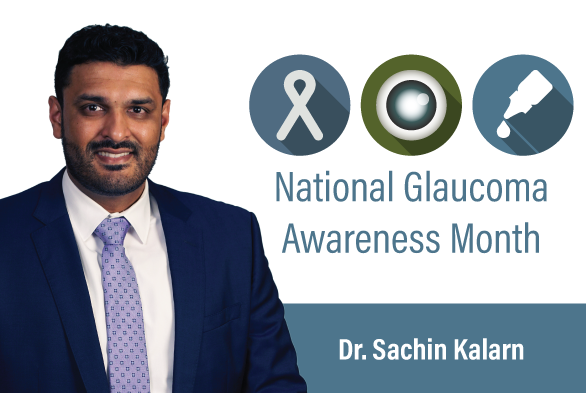By Dr. Sachin Kalarn
The month of January is National Glaucoma Awareness Month.
According to the National Eye Institute (NEI), more than 3 million people in the United States currently have glaucoma, and it is estimated that half of these individuals are unaware they have the disease.
But the most alarming statistic of all is that this number is projected to increase by 58 percent in 2030 when it is estimated that glaucoma will affect 4.2 million people.
One of our primary goals at Illinois Eye Center is to raise awareness of this devastating eye disease and do our best to help to protect our patients from advanced stages of glaucoma.
What is Glaucoma?
Glaucoma is an age-related eye disease that damages the optic nerve and can lead to vision loss. Much like high blood pressure, it is known as a silent disease and is the number one cause of irreversible blindness in the world.
But what makes glaucoma unique and especially dangerous is that it can reduce up to 40% of a person’s eyesight before they even know they have the disease. People typically have no warning signs or symptoms in the early stages, which is why detection via an annual eye exam is key.
Who Should be Screened for Glaucoma?
There are three specific groups of patients we encourage to be screened for glaucoma.
They are:
- All patients who are 40 years or older in age.
- All patients who have a family member with glaucoma.
- All patients who have had trauma to the face or eye.
If you fall into at least one of these categories, we strongly encourage you to schedule an appointment with our office for a glaucoma screening.
You should also consider coming in for an eye exam if you are experiencing blurred vision, halos, mild headaches, or eye pain, as these symptoms may also be signs of angle-closure glaucoma.
What Does a Glaucoma Screening Entail?
In the past, the standard glaucoma screening was the “puff of air” test.
During this test, a small burst of air would be sent into the eye and it would bounce back into a device called a tonometer, which would then produce a reading of intraocular pressure (IOP), or pressure inside the eye.
Thanks to advancements in technology, we now have more accurate ways to test for glaucoma that are still 100% pain free.
When you come in for your glaucoma screening, we will measure the pressure in your eyes and examine your optic nerve for damage, inspect your eye’s drainage angle, test your peripheral vision, and measure the thickness of your cornea.
This simple procedure gives us a clear picture of the health of your eyes and will alert us if any early signs of glaucoma exist.
Treatment Options for Glaucoma
While the damaging effects of glaucoma are irreversible, treatment options are available to help preserve your vision.
Simple treatments, such as eye drops, may be prescribed to lower pressure in the eye and multiple laser and surgical procedures may be available depending on your diagnosis.
As we begin the new year, our hope is that all our patients who are at higher risk for glaucoma will come in for a screening. This is the number one way we can help protect you from severe vision issues caused by this disease.
Our goal is to diagnose this potentially devastating eye disease as early as possible, slowing the natural progression of the disease, and allowing our patients to maintain good vision.
Happy New Year and we hope to see you soon!


